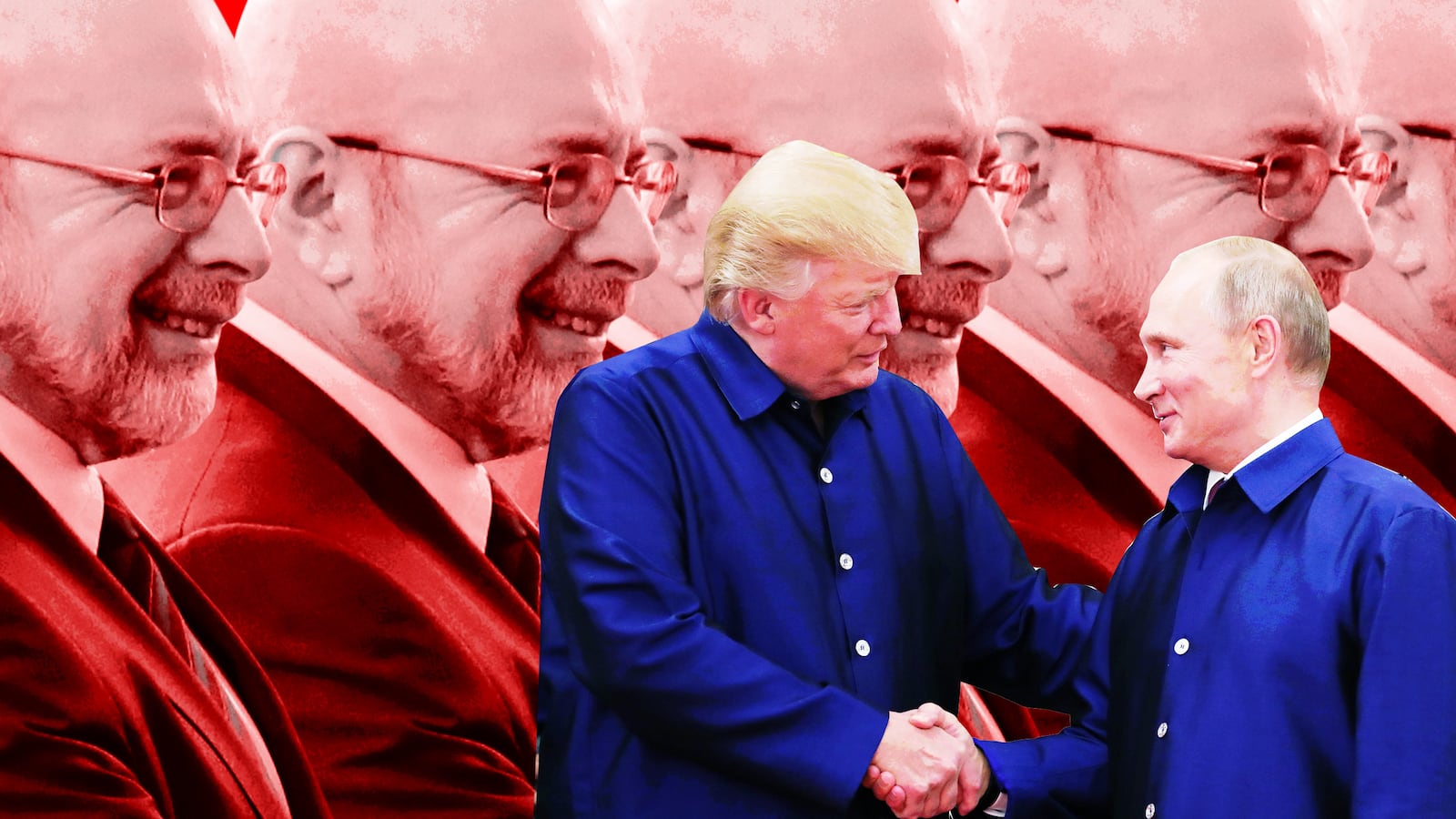In the morning of April 21, 2016, a staffer at the Center for the National Interest, a Washington D.C., think tank, wandered into the office of Dimitri Simes, the group’s president.
The staffer saw a pile of papers on the desk titled “FOREIGN POLICY AND DEFENSE OUTLINE.” The staffer realized the papers were the detailed outline, in bullet-pointed paragraphs, of a major foreign-policy address that then-candidate Donald Trump was set to deliver six days later as a guest of the center. The staffer used a cellphone to snap pictures of all five pages of the document.
More than two years later, Maria Butina, who once wrote for the center’s magazine and occasionally emailed with Simes, was arrested as an accused Kremlin agent. Subsequently, the person provided the photos to The Daily Beast. The photos’ metadata confirm they were taken on a cellphone on the morning of April 21, 2016. A second former staffer told The Daily Beast that he saw the same documents on Simes’ desk.
The pictures provide new insight into the creation of Trump’s historic foreign-policy speech. They also indicate that Simes was closer than previously known to the drafting of that speech. (Jacob Heilbrunn, the editor of the center’s magazine, wrote for Politico shortly after the speech that he didn’t know what was going to be in it. “I was curious as anyone to see what Trump would actually say,” he wrote.)
It isn’t unusual for a think tank chiefs to preview drafts of a speeches presented at their invitation. But Simes’ proximity to the speech shows that he had an early view into the crafting of a speech that would have historic significance for American foreign policy. Democrats on the House intelligence committee tried to investigate Simes’ relationship to Trump’s campaign, but Republican committee Chairman Devin Nunes blocked their efforts.
Presented with this account and with the pictures of the document, the center’s executive director, Paul Saunders, declined to comment. Heilbrunn emailed that he did not receive any preview of the speech. Simes did not respond to a request for comment but wrote in a Wall Street Journal op-ed on Sept. 5, 2018, that his think tank’s interaction with the Trump campaign had a “small scope.” Michael Glassner, the chief operating officer at Donald J. Trump for President, did not respond to multiple requests for comment. J.D. Gordon, a foreign-policy adviser to Trump on the 2016 campaign, told The Daily Beast he was not familiar with the document.
The pictures demonstrate that significant changes were made from the speech’s detailed outline to its final version—including the removal of lines condemning bigotry, praising legal immigration, and disparaging Russia.
The speech Trump ultimately delivered—a transcript is available here—had some notable differences from the lengthy outline that found its way to Simes’ desk. The document on Simes’ desk listed four main weaknesses in American foreign policy: overstretched resources, an unclear understanding of foreign-policy goals, allies afraid they cannot trust the U.S., and the disrespect of rivals.
The speech Trump delivered a week later, on April 27, included one more bullet-pointed weakness: “Our allies are not paying their fair share,” Trump proclaimed. The same concern is detailed in the document from Simes’ desk, but with less prominent billing. It’s a talking point Trump has been hammering for nearly two decades and continues to use in meetings with America’s NATO allies.
The outline also criticized American intervention in the Balkans under the Clinton administration—a move also criticized by the Kremlin. “Look what happened in the 1990s,” the outline said. “Even after the attacks on the USS Cole and our embassies in Kenya and Tanzania, we continued to pursue nation-building in the Balkans. Then we got hit on 9/11, because our leaders were not sufficiently focused on the security of the American people.”
When Trump delivered his speech a week later, he didn’t mention the Balkans.
The outline also included a line speaking out against prejudice. “I reject bigotry of all kinds,” the document from Simes’ desk reads. “And I reject Senator Cruz’s proposal to patrol Muslim neighborhoods in our country. That is wrong.” In his final speech, Trump didn’t speak about bigotry in general or Cruz’s proposal to patrol Muslim neighborhoods in particular.
Trump’s outline also suggested spending $100 billion or more on the military; that number doesn’t appear in his final speech.
Another line in the outline that didn’t appear in the final version: “I believe we need legal immigrants, who make a huge contribution to our economy. We can protect American workers and their way of life without being protectionist.”
The outline also included a negative comment about Russia that didn’t appear in the final speech. “Russia is a declining but proud country with a nuclear arsenal that could obliterate our country,” the outline reads.
Politico later reported that Trump received assistance writing the speech from Richard Burt, a member of the center’s board who was lobbying at the time for a natural-gas project controlled by the Kremlin.
Simes attracted scrutiny from House Intelligence Committee Democrats when they investigated Russian meddling in the 2016 presidential race. But committee Republicans decided against compelling Simes to answer questions or produce documents. In a minority report released when Republicans ended their Russia probe earlier this year, committee Democrats listed him as a key witness—evidence, in their view, that the investigation was incomplete.
“The Committee is investigating matters related to the speech and communications that may have occurred at the event, and the Committee has reason to believe that Mr. Simes played a central role in drafting portions of the speech related to Russia,” committee Democrats wrote. “The Committee should also obtain relevant personal correspondence between Mr. Simes and Trump campaign officials and any individuals with direct or assumed links to the Russian government.”
Simes, who was born in Moscow and served as an adviser to Richard Nixon, has distinguished himself from the largely monolithic Washington think-tank crowd by his working relationships with Kremlin officials—and, as The Daily Beast has reported, his apparent effort in one instance to use those connections to try to assist one of his organization’s most generous benefactors. Under his leadership, the center has argued for more effective cooperation between Washington and Russia on some issues. It also gets notable access to some Russian government officials; in March of last year, Russian Foreign Minister Sergei Lavrov sat for a lengthy interview with the center’s executive director in Moscow.
Both the outline found on Simes’ desk and the speech the future president delivered at the Mayflower Hotel in downtown Washington called for warmer relations with Moscow.
“I believe an easing of tensions and improved relations with Russia—from a position of strength—is possible,” he said in the speech. “Common sense says this cycle of hostility must end. Some say the Russians won’t be reasonable. I intend to find out.”





